Mammals of the Adirondacks:
American Marten (Martes americana)
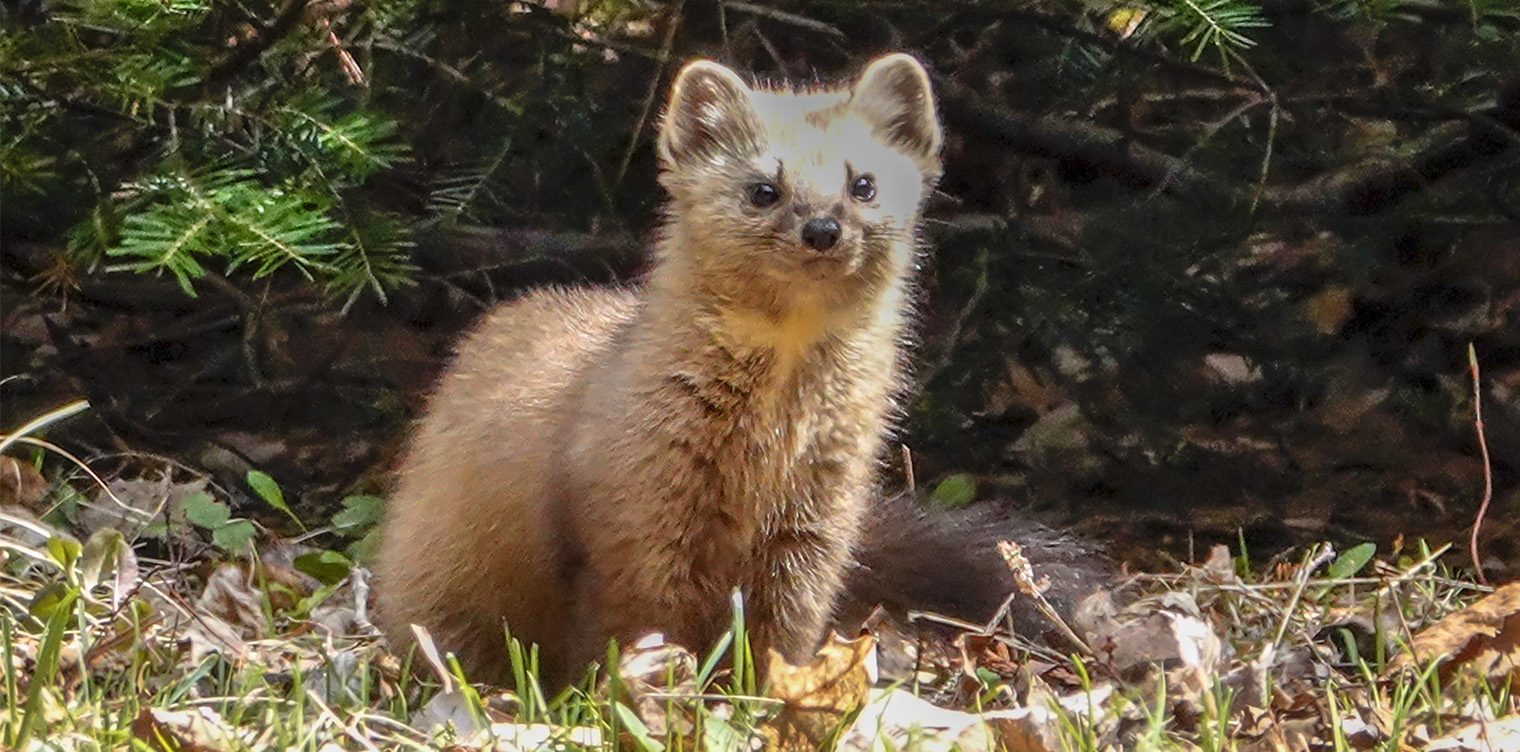
The American Marten (Martes americana) is a small, slender-bodied mammal found in conifer and mixed forests in the central Adirondacks and High Peaks regions. American Martens (like the Gray Fox, Eastern Coyote, Raccoon, Red Fox, and Bobcat) are part of the carnivore (Carnivora) order.
The American Marten is one of six members of the Mustelid family (Mustelidae) who make their home in the Adirondacks. The other members are:
- American Mink (Mustela vison)
- Ermine (Mustela erminea)
- Fisher (Pekania pennanti)
- Long-tailed Weasel (Mustela frenata)
- North American River Otter (Lontra canadensis)
The name Mustelid is a reference to the strong repellent smell that members of this family use to mark their territories.
Sources differ on the number of subspecies, with some listing 12 and others listing 14. Two subspecies groups have been recognized: the Martes americana americana subspecies group and the Martes americana caurina subspecies group. At one point, these groups were described as two species: the American Marten and the Pacific Marten. They were later merged into a single species. However, more recent morphometric and phylogeographic studies cast doubt on this decision, and some researchers favor a return to the previous division of North American martens into two different species: the American Marten and the Pacific Marten.
Other nonscientific names of the American Marten include the Pine Marten and the American Pine Marten. These names reflect the species' resemblance to the European Pine Marten (Martes martes). Nonscientific names found in older literature include Marten cat, American sable, Canadian sable, sable, and Hudson Bay sable.
American Marten: Description
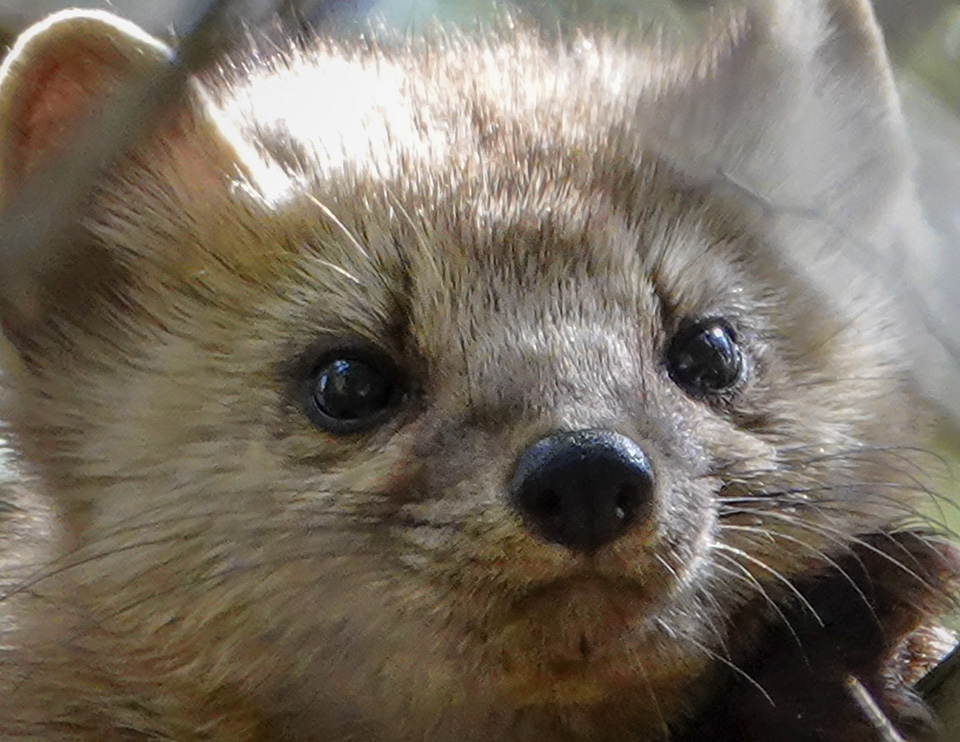
American Martens are long, slender-bodied mammals with short legs, a triangular head, pointed snout, and large, rounded ears. The eyes are bright, black, and beady; the nose is black. The bushy tail is about a third of the animal's total weight. American Martens have a general weasel shape, but lack the extreme elongation of the weasels.
Weight ranges from 1½ to about 3 pounds. Males average 15% larger than females in body length and as much as 65% larger in body weight. Although the American Marten has been described in several sources (Whitaker and Hamilton, 1998, Buskirk and Zielinski, 1997) as "about the size of a small house cat," this comparison is misleading, since domestic cats (averaging about 10 pounds) are much larger. A female American Marten (averaging 1.3 to 1.7 pounds) is much closer in weight to a Gray Squirrel (averaging 1 to 1½ pounds).
American Martens have long, dense, silky fur, ranging in color from pale yellowish buff to tawny brown to almost black. The feet, legs, and tail are darker than the rest of the body, while the head is lighter with irregular orange, buffy orange, or cream colored patches on the throat and chest. The feet are large, giving the animal the ability to walk on deep snow. The five toes on each foot have sharp, recurved, semi-retractile claws.
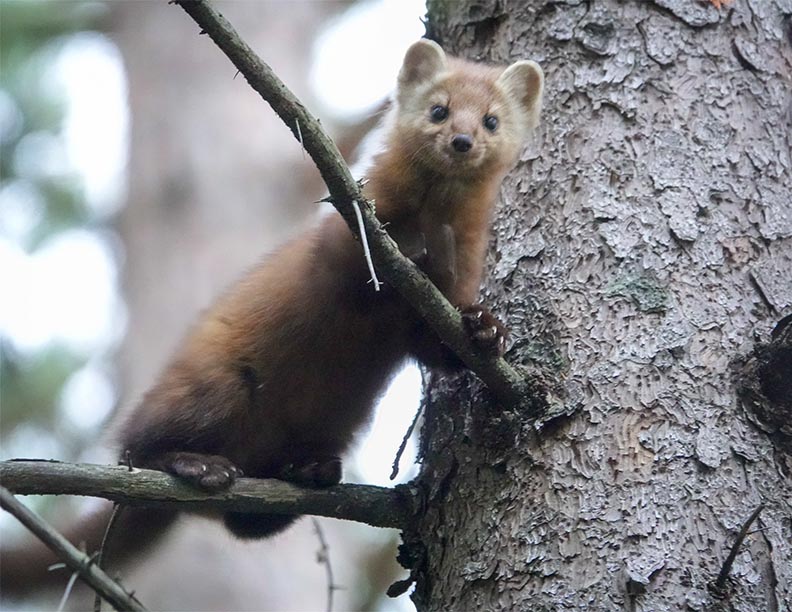
The main clues to identifying the American Marten and distinguishing it from other Mustelids found in the Adirondacks are size, color, markings, and habitat.
- Fishers are significantly larger than American Martens, ranging in weight from 8-13 pounds (males) and 4-6 pounds (females). Their coats are deep brown to black, and they lack the orange throat and chest patch.
- American Minks, like the American Marten, have a streamlined body shape and bushy tail, and they are similar to the American Marten in size (with a weight ranging from 1-3 pounds for males and 1-2 pounds for females). However, the fur of the American Mink is dark chocolate brown; the chin and lower lip are white. Moreover, American Minks are semiaquatic and are usually found in or near water bodies.
- Long-tailed Weasel and Ermine are considerably smaller than the American Marten, and both have a much more elongated shape. These weasels are easy to distinguish from the American Marten in winter, because both sport snow-white fur with a prominent black tip on the tail. The coats of American Martens, by contrast, do not turn white in winter. In summer, Ermines have sandy-brown fur on the back and head, with white below; the tail retains the prominent black tip. Long-tailed Weasels in summer are also brown above and whitish below, with a black-tipped tail.
American Marten: Diet
The American Marten is an omnivore Omnivore: Animals that eats both plant- and animal-derived food. Carnivores (meaning "meat-eaters" in Latin) are animals that feed on other animals; obligate carnivores (such as members of the cat family) rely entirely on animal flesh, while facultative carnivores supplement their diets with non-animal foods. Herbivores feed exclusively on plants, although some may supplement their diets with small amounts of insects or other animals. , meaning that it consumes both plant and nonplant material. However, the bulk of their diet consists of small mammals, especially rodents. They prey on Southern Red-backed Voles, Red Squirrels, Eastern Chipmunks, Northern Flying Squirrels, mice, moles, and shrews. Snowshoe Hares may also be taken, especially in winter. American Martens will also eat birds, birds' eggs, insects, reptiles, amphibians, earthworms, and carrion.
American Martens use a variety of hunting methods, including ambush, excavation, and hunting perches. During the winter, they forage beneath the snow for small mammals. Although American Martens are at home in the trees, they are not primarily arboreal hunters; they hunt mostly on the ground.
The American Marten's summer menu includes fruit, particularly blueberries and raspberries. In late summer and fall, fruit may constitute up to 30% of their diet.
American Marten: Reproduction and Family Life
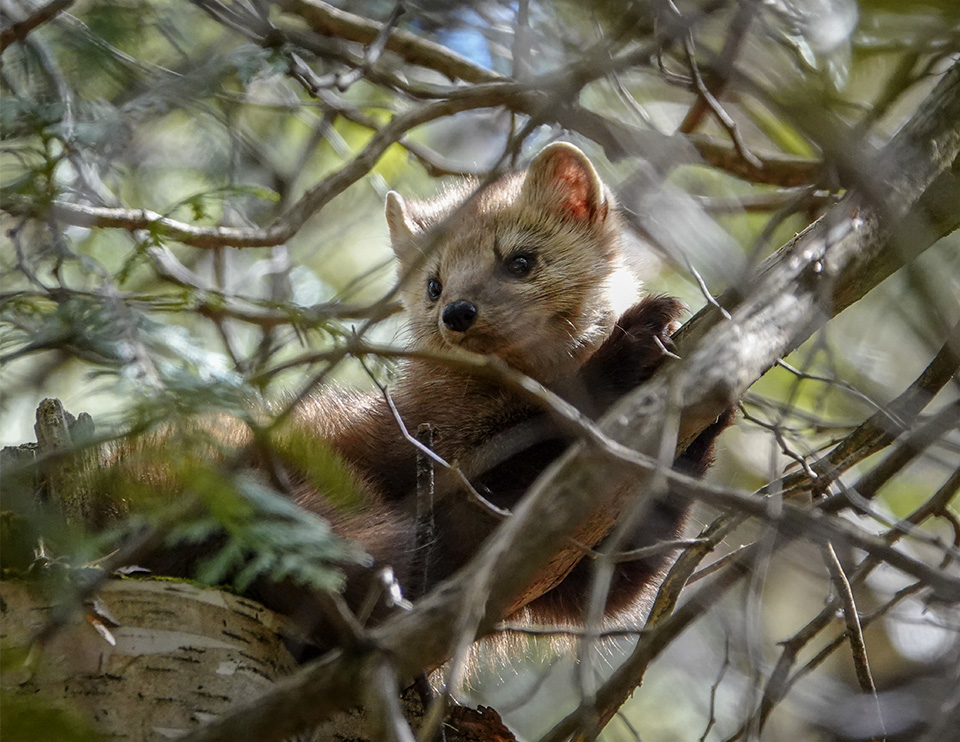
The breeding season for American Martens occurs in July and August. However, implantation of the embryos is delayed until late winter, with females giving birth in late March or April. Female American Martins give birth to and shelter their kits in dens, located in tree cavities, snags, stumps, logs, woody debris piles, Red Squirrel nests, or witches' brooms (a dense mass of shoots in a tree resembling a bird's nest).
Female American Martens typically give birth in a natal den lined with grass, moss, and leaves, and move their kits to new maternal dens after birth. Litter sizes range from one to five, with a typical litter size of three to four.
American Martens are born completely helpless. Their eyes and ears are closed, and they are partially covered with fine hair. Weening occurs at about 42 days, and the young emerge from the dens about a week later. Kits stay with their mother until they are about three months old, when they reportedly reach adult body weight. The timing of juvenile dispersal varies, ranging from early August to October.
American Marten: Behavior
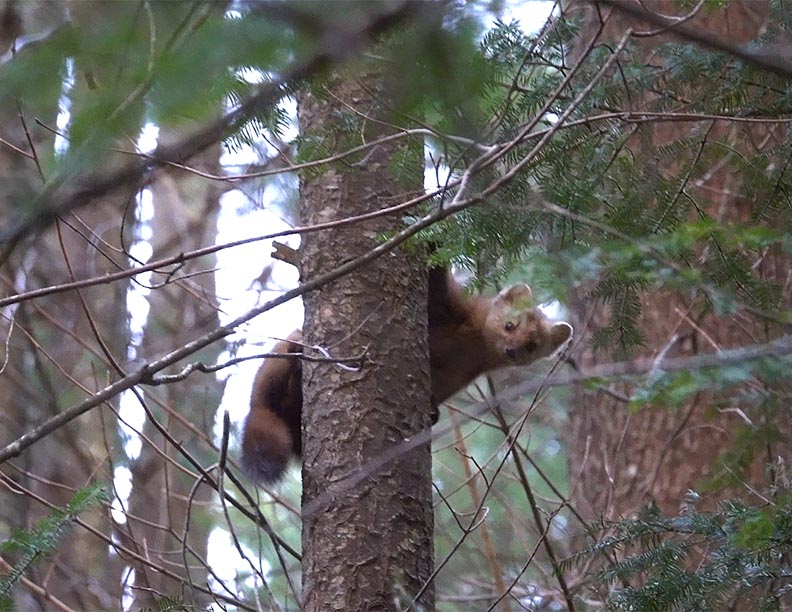
Activity Patterns:
American Martens do not hibernate, but are active throughout the year. Although seasonal activity patterns vary by region, most studies have found that activity levels are higher in summer than in winter. For instance, a 1994 study of American Marten activity patterns in Ontario found that activity declined from around 14 hours per day in summer to about 4 hours per day in late winter.Daily activity patterns of American Martens also vary by region and season. Some studies found that American Martens are primarily diurnal Diurnal: Active during the day, followed by a period of inactivity or sleeping during the night. Nocturnal animals are active primarily at night, while animals that are active in the twilight hours (dawn and dusk) are crepuscular., while others found that this mammal is crepuscularCrepuscular: Refers to animals that are active primarily during twilight (dusk and dawn). This activity pattern contrasts with that of animals which are diurnal (active during the day), as well as those that are nocturnal (active during the hours of darkness). or nocturnalNocturnal: Animal behavior characterized by being active during the night and sleeping during the day. Nocturnal animals often have highly developed senses of hearing and smell, and specially adapted eyesight to help them get around in the dark.. Studies conflict on the reason for this variability in American Marten daily activity patterns.
- Some researchers see a link between American Marten activity levels and that of their dominant prey, which varies by season and region. American Martens may be more active at night during the winter, because that is the time their prey species (Snowshoe Hares and small rodents) are active. Conversely, American Martens may be more active during the day in the summer, when prey such as Eastern Chipmunks are out and about. For instance, a 1983 study of the relationship between diet and American Marten activity patterns in the Tahoe National Forest of California found that American Marten foraged at night during winter and by day during summer. This pattern was not associated with ambient temperature, but rather appeared synchronized with the activity of prey.
- Other researchers found that activity levels correlated with ambient temperatures, rather than prey availability. For instance, a 1994 study of American Marten activity patterns in Ontario failed to find a link between prey activity patterns and the activity patterns of the American Marten. The researchers concluded that American Marten activity levels in winter were largely influenced by the need to conserve energy, particularly when temperatures are below -15 C.
Although American Martens are expert climbers, they are also at home on the ground, where they do much of their hunting. They often use fallen logs for runways. This species makes use of resting sites, generally chosen based on their potential for thermal cover and protection from predators. They use a variety of structures as resting sites, including logs, stumps, ground burrows, and rock piles, with an apparent preference for resting in trees, particularly in summer.
Social System:
American Martens are generally solitary mammals who avoid contact with each other except during mating season. Adult American Martens occupy home ranges. Home range size varies regionally, apparently depending on habitat and the densities of prey animals. Males have larger ranges than females. A male's home range may include the ranges of several females. Home ranges of males, however, do not usually overlap. Males appear to be intolerant of each other, and they associate with females only during the summer courtship and mating period.Communication:
Both male and female American Martens mark their home ranges with scent from abdominal and anal glands. This species is said to be relatively quiet. During agonistic encounters, they may emit a variety of vocalizations, including hisses, screams, huffs, growls, or whines. While American Martens are said to be shy, they are somewhat curious about human interlopers and may respond to a human's presence with low chucking sounds, while staring at them inquisitively from the safety of trees.American Marten: Mortality and Predators
The potential life span of American Martens is between 15 and 17 years. Life expectancy in wild populations is lower. Survival rates vary by region, habitat quality, and exposure to trapping.
The American Marten's main predator is man. In New York State, the American Marten is one of 14 species of mammals than may be trapped in New York State.
- American Martens may be trapped from 1 November through 30 November in the Adirondack Park. To trap this animal, you need to obtain a special free trapping permit from a Regional Bureau of Wildlife Office. There is a season bag limit of six American Martens. If you kill one, you must complete a furbearer possession tag and get the pelt or unskinned animal sealed.
- New York State data show that the number of American Martens killed is much lower than that of other furbearers. During the 2020-2021 trapping season, only 199 American Martens were killed in the state, most in the central Adirondacks. This compares to 1,8302 for Fishers, 838 for Otters, and 518 for Bobcats.
Other than man, the American Marten has few other serious predators. Fishers, Red Foxes, Eastern Coyotes, and Bobcats may occasionally kill American Martens. Avian predation appears to be less frequent. Other sources of mortality include starvation, drowning, exposure, and infections associated with injury.
American Marten: Distribution
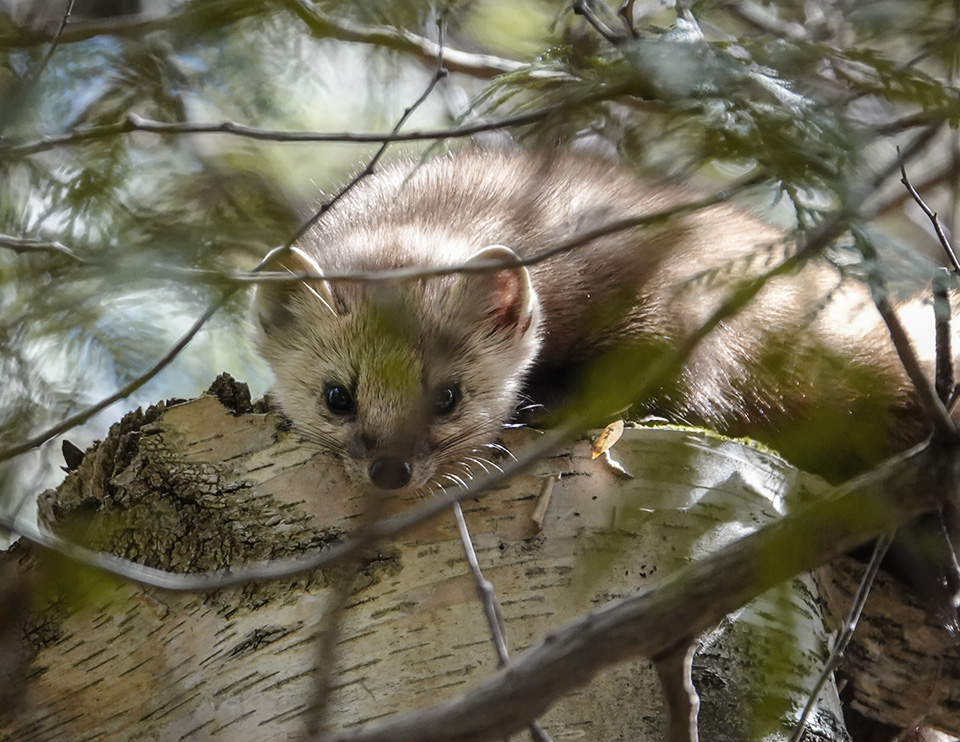
In the colonial era, The American Marten was widely distributed in the eastern United State, from Maine south to Virginia and west to Wisconsin. Habitat reduction and trapping extirpated the species over much of its range. The species has been successfully reintroduced in some areas where extirpation had occurred.
The American Marten's current range includes much of northern North America. It can be found from the northern limit of the tree line in arctic Alaska and Canada to northern New Mexico, and from Newfoundland west to parts of California. The ICUN (International Union for Conservation of Nature) identified the American Marten as species of least concern, although its population trend is decreasing.
In New York State, the American Marten's current range reflects the impact of past unregulated logging and trapping. In the 1800s, the species was common throughout forested areas in the state. By 1936, its range had shrunk from nearly the entire state to the central Adirondacks. Since that time, the species has recolonized most of the Adirondacks, thanks to either complete protection or the imposition of special trapping seasons.
At the present time, the American Martin within New York State appears to be limited to the Adirondack Park. The species is most abundant in the High Peaks, but now occurs through most of the Park, as well as adjacent areas beyond the Blue Line, including the Tug Hill Plateau and the Sable Highlands near Malone. American Martens are absent or much less common in some of the southeastern counties within the Blue Line.
American Marten Habitat
Throughout their range, American Martens are found mainly in mature conifer or mixed forests, although they may also live in mature or young deciduous forests. This species favors closed, coniferous woodlands (as well as cedar swamps). These habitats combine overhead cover with coarse woody debris on the forest floor that provide suitable habitat for the small mammals that provide a major food source for the marten.
Although some studies have shown that American Martens tend to be somewhat less abundant in recently-logged areas, burned areas, and other open sites, a 1980 study of American Martens focusing on the Adirondacks High Peaks and central Adirondacks regions, found that American Marten habitat was quite diverse. American Martens were live-trapped in a wide variety of habitats, including hardwood forests, mixed stands recovering from burns, as well as softwood stands at the base of Mount Marcy.
Adirondack Mammal List
References
New York State Department of Environmental Conservation. American Marten. Retrieved 30 March 2017.
New York State Department of Environmental Conservation. New York Furbearer Newsletter. Fall 2021. Retrieved 9 November 2022.
New York State Department of Environmental Conservation. Statewide Totals. Pelt-Sealed Marten in New York State 2020–2021. Retrieved 9 November 2022.
New York State Department of Environmental Conservation. Furbearers. Retrieved 18 April 2021.
New York State Department of Environmental Conservation. Fisher and Marten Trapping Seasons. Retrieved 9 November 2022.
New York State Department of Environmental Conservation. Trapping Seasons. Retrieved 18 April 2021.
New York State Department of Environmental Conservation. New York Hunting & Trapping 2022–2023. Official Guide to Laws & Regulations. Retrieved 9 November 2022.
State University of New York. College of Environmental Science and Forestry. American Marten. Martes americana Turton. Retrieved 23 December 2020.
Katharine Stone, Martes americana, American Marten in Fire Effects Information System (FEIS). Species Reviews. Forest Service, Rocky Mountain Research Station, Fire Sciences Laboratory (United States Department of Agriculture, 2010). Retrieved 9 November 2022.
Tim W. Clark, Elaine Anderson, Carman Douglas and Marjorie Strickland, “Martes americana,” Mammalian Species, Number 289 (12 August 1987), pp.. 1-8. Retrieved 13 April 2021.
Integrated Taxonomic Information System On-line Database. Martes americana. Retrieved 13 April 2021.
K. Helgen, and F. Reid, Martes americana. The IUCN Red List of Threatened Species 2016. Retrieved 13 April 2021.
D. Andrew Saunders. Adirondack Mammals (Adirondack Wildlife Program. State University of New York. College of Environmental Science and Forestry, 1988 ), pp. 169-172.
John O. Whitaker, Jr. and William J. Hamilton, Jr. Mammals of the Eastern United States. Third Edition (Cornell University Press, 1998), pp. 434-438. Retrieved 13 April 2021.
iNaturalist. American Marten. Martes americana. Retrieved 9 November 2022.
iNaturalist. Adirondack Park Sightings. American Marten. Martes americana. Retrieved 9 November 2022.
Alexander C. Martin, Herbert S. Zim, and Arnold L. Nelson. American Wildlife & Plants. A Guide to Wildlife Food Habitss (Dover Publications, 1951), pp. 222-223. Retrieved 13 April 2021.
James M. Ryan. Adirondack Wildlife. A Field Guide (University of New Hampshire Press, 2008), pp. 203-204.
Richard M. DeGraaf and Mariko Yamasaki. New England Wildlife: Habitat, Natural History, and Distribution (University Press of New England, 2001), pp. 347-348. Retrieved 13 April 2021.
Richard M. DeGraaf, Gretchin M. Witman, and Deborah D. Rudis. Forest habitat for Mammals of the Northeast (US Department of Agriculture. Forest Service, 1981), pp. 132-134. Retrieved 12 April 2021.
Roger A. Powell, Steven W. Buskirk, and William J. Zielinski, "Fisher and Marten," in George A. Feldhamer, Bruce C. Thompson, and Joseph A. Chapman (Eds). Wild Mammals of North America: Biology, Management, and Conservation. Second Edition (The Johns Hopkins University Press, 2003) pp. 635-649 .
Allen Kurta. Mammals of the Great Lakes Region. Revised Edition. (University of Michigan, 1995), pp. 223-226. Retrieved 12 April 2021.
Rollin H. Baker. Michigan Mammals (Michigan State University Press, 1983), pp. 455-463. Retrieved 12 April 2021.
William H. Burt. The Mammals of Michigan (University of Michigan Press, 1946), pp. 127-130. Retrieved 26 December 2020.
Clinton Hart Merriam. The Mammals of the Adirondack Region, Northeastern New York (Self-published, 1884), pp. 52-54. Retrieved 2 March 2017.
Gerrit S. Miller, “Preliminary List of New York Mammals,” Bulletin of the New York State Museum, Volume 6, Number 29 (October 1899), pp. 273-390. Retrieved 15 November 2020.
W. J. Hamilton, Jr., “Past and Present Distribution of Marten in New York,” Journal of Mammalogy, Volume 39, Number 4 (November 1958), pp. 589-591. Retrieved 23 December 2020.
Raymond D. Masters, “Daytime Resting Sites of Two Adirondack Pine Martens,” Journal of Mammalogy, Volume 61, Number 1 (February 1980), p. 157, Retrieved 23 December 2020.
William J. Zielinski, Wayne D. Spencer and Reginald H. Barrett, “Relationship between Food Habits and Activity Patterns of Pine Martens,” Journal of Mammalogy, Volume 64, Number 3 (August 1983), pp. 387-396. Retrieved 23 December 2020.
Natalie G. Dawson and Joseph A. Cook, “Behind the Genes: Diversification of North American Martens (Martes americana and M. Curina),” in Keith B. Aubry, William J. Zielinski, Martin G. Raphael, Gilbert Proulx, and Steven W. Buskirk (eds.). Biology and Conservation of Martens, Sables, and Fishers: A New Synthesis (Cornell University Press, 2012), pp. 23-38.
Ian D. Thompson, John Fryxell, and Daniel J. Harrison, ”Improved Insights into Use of Habitat by American Martens,” in Keith B. Aubry, William J. Zielinski, Martin G. Raphael, Gilbert Proulx, and Steven W. Buskirk (eds.). Biology and Conservation of Martens, Sables, and Fishers: A New Synthesis (Cornell University Press, 2012), pp. 209-230.
Steven W. Buskirk and William J. Zielinski, “American Marten (Martes americana) Ecology and Conservation,” in J.E. Harris and C.V. Ogan, (eds.), Mesocarnivores of Northern California: Biology, Management, and Survey Techniques. Workshop Manual. (The Wildlife Society, California North Coast Chapter, 1997), pp. 17-22. Retrieved 26 December 2020.
George Reid Francis. Ecological Studies of Marten (Martes Americana) in Algonquin Park, Ontario (Master’s Thesis. University of British Columbia, 1958). Retrieved 26 December 2020.
Paul G. Jensen, Charlotte L. Demers, Stacy A. Mcnulty, Walter J. Jakubas and Murray M. Humphries, “Marten and Fisher Responses to Fluctuations in Prey Populations and Mast Crops in the Northern Hardwood Forest,” The Journal of Wildlife Management, Volume 76, Number 3 (April 2012), pp. 489-502. Retrieved 10 February 2019.
Mark K. Brown, “The Status of the Pine Marten in New York,” Transactions of the Northeast Section, the Wildlife Society, 37th Northeast Fish and Wildlife Conference, 1980, pp. 217-226. Retrieved 13 April 2021.
Ian D. Thompson and Patrick W. Colgan, “Marten Activity in Uncut and Logged Boreal Forests in Ontario,” The Journal of Wildlife Management, Volume 58, Number 2 (April 1994), pp. 280-288. Retrieved 17 April 2021.
Ingrid Belan, Philip N. Lehner and Tim Clark, “Vocalizations of the American Pine Marten, Martes americana,” Journal of Mammalogy, Volume 59, Number 4 (November 1978), pp. 871-874. Retrieved 17 April 2021.
Francois Potvin and Laurier Breten, “Short-Term Effects of Clearcutting on Martens and Their Prey in the Boreal Forest of Western Quebec,” in Harold N Bryant, Paul M Woodard and Gilbert Proulx (eds.), Martes: Taxonomy, Ecology, Techniques, and Management: Proceedings of the Second International Martes Symposium (Provincial Museum of Alberta, 1997), pp. 452-474. Retrieved 18 April 2021.
Thomas P. Hodgman, Daniel J. Harrison, David M. Phillips, and Kenneth D. Elowe, “Survival of American Marten in an Untrapped Forest Preserve in Maine,” in Harold N Bryant, Paul M Woodard and Gilbert Proulx (eds.), Martes: Taxonomy, Ecology, Techniques, and Management: Proceedings of the Second International Martes Symposium (Provincial Museum of Alberta, 1997), pp. 86-99. Retrieved 18 April 2021.
Curtis H. Halvorson, “Curiosity of a Marten,” Journal of Mammalogy, Volume 42, Number 1 (February 1961), pp. 111-112. Retrieved 18 April 2021